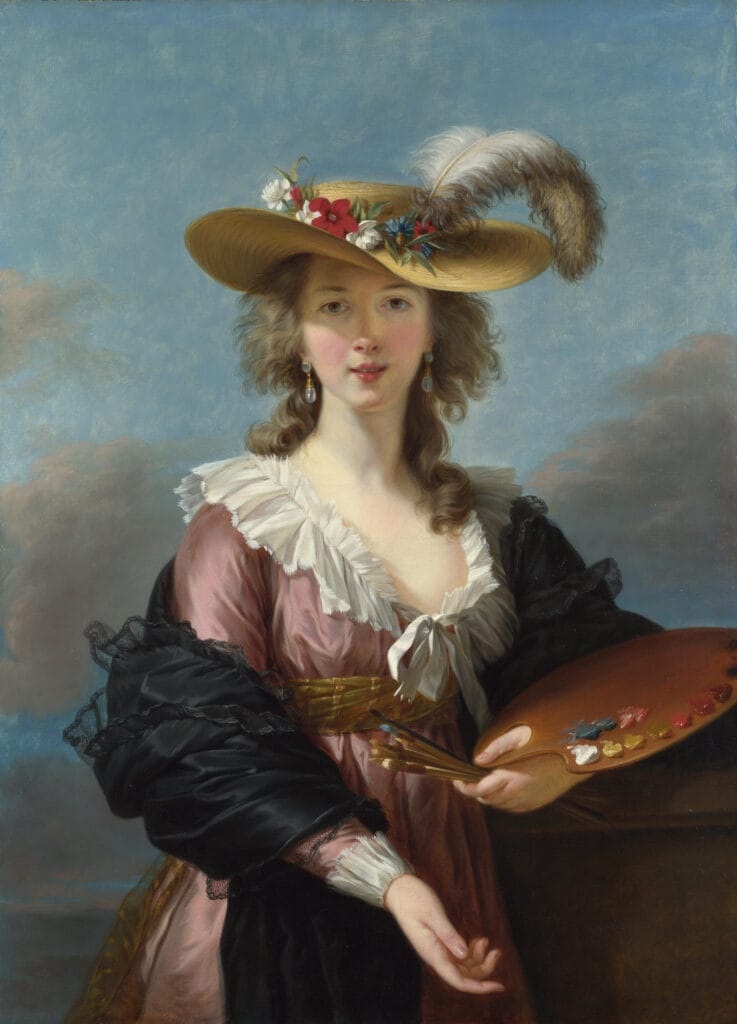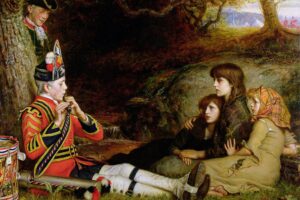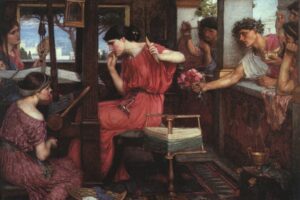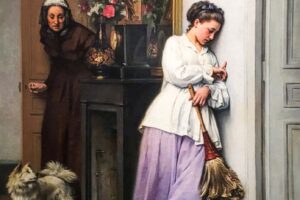By the Light of Her Hand
Princess Anna Alexandrovna Galitzine Teaching Her Eldest Son Prince Andrei Borisovich the Virtues of His Ancestors – Élisabeth Louise Vigée Le Brun, c. 1797 – Neoclassicism
Painted around 1797 by Élisabeth Louise Vigée Le Brun, this neoclassical composition captures a timeless lesson unfolding between mother and son. It is not merely a portrait—it is a moment of transmission, where ideals pass from one generation to the next.
In a world reshaped by revolution and reason, this painting reminds us that character and virtue are not inherited by blood alone—they must be taught, guided, and remembered.
The Scene Before Us
Set within a grand classical hall lined with busts of noble figures, the painting shows Princess Anna Galitzine seated upon a Roman-style couch, her robes cascading around her in gentle folds. Her son, the young Prince Andrei Borisovich, stands beside her, his youthful expression lifted in attention.
Her arm extends with graceful authority, pointing toward a row of sculpted busts—honored ancestors whose marble gazes echo through the hall. She does not lecture; she inspires. Her other arm draws her son close, holding him not just in love, but in responsibility.
Light enters from the left, illuminating the warmth of skin, the softness of fabric, and the quiet dignity of this teaching moment. In the shadows behind them, statues and symbols of justice and philosophy complete the lesson in silence.
The Deeper Meaning
Vigée Le Brun, one of the few prominent female painters of her era, wields this canvas not for display but for meaning. The work is steeped in neoclassical ideals—reason, virtue, legacy, and civic duty—all wrapped in the quiet dignity of motherhood.
Princess Anna is portrayed not as a passive aristocrat, but as a moral guide. Her lesson to her son is not one of wealth or title, but of responsibility—to be worthy of the name he bears, to honor those who came before him not just with pride, but with action.
The busts lining the pillars represent more than ancestors—they are models. Their gaze, though silent, seems to hold expectation. The boy, wide-eyed and impressionable, stands on the edge of choice—will he follow the virtues he’s being taught?
A Moment Caught in Time
This is a painting of formation, not celebration. The drama is interior. We do not see armies, crowns, or palaces—but we see the forging of a soul.
In this quiet space between generations, we witness a kind of sacred trust: a mother shaping her son not for privilege, but for purpose. The neoclassical setting reminds us that wisdom comes from remembering, that civilization advances when each generation teaches the next not just what they are, but who they ought to be.
About Artist

Élisabeth Louise Vigée Le Brun was born on April 16, 1755, in Paris, France, and died on March 30, 1842, in Paris. She was one of the most famous portrait painters of the late 18th and early 19th centuries, particularly celebrated for her portraits of Marie Antoinette and the French aristocracy. Born to the pastel artist Louis Vigée, she was trained early in art by her father and was largely self-taught thereafter. She married the art dealer Jean-Baptiste-Pierre Le Brun in 1776.
Vigée Le Brun became the official portraitist to Queen Marie Antoinette in 1778 and created about 30 portraits of the queen over the following decade. Her work skillfully blended Rococo grace with neoclassical influences, and she was known for capturing her sitters with a natural, intimate pose, soft light, and elegant brushwork. Despite her royal connections, she fled France during the Revolution for safety, traveling and working throughout Europe, including Italy, Austria, and Russia, where she continued to paint aristocratic patrons
She produced over 660 portraits and 200 landscapes and was admitted to the Royal Academy of Painting and Sculpture in 1783, a rare honor for a woman at that time. In her later years, she published her memoirs, offering insight into her life and art.
Artistic Style
Vigée Le Brun’s style combined the lingering Rococo’s soft colors and elegance with the order and simplicity of neoclassicism, though she never adopted the harsher lines of early Neoclassical painters like Jacques-Louis David. Her portraits are noted for their lyrical and naturalistic qualities, conveying warmth and immediacy while maintaining aristocratic dignity. She excelled at rendering luxurious textures like silk and satin and capturing subtle emotional expressions, making her subjects appear approachable yet grand.
Notable Artworks
- Princess Anna Alexandrovna Galitzine Teaching Her Eldest Son Prince Andrei Borisovich the Virtues of His Ancestors (c. 1797): A tender portrait capturing maternal teaching and the transmission of noble virtues, exemplifying warmth, clarity, and aristocratic dignity.
- Marie Antoinette and Her Children (1787): A large group portrait symbolizing royal motherhood and legacy, combining formal grandeur with intimate emotional depth during a turbulent pre-revolutionary time.
- Marie Antoinette with a Rose (1783): A famous single portrait showcasing the queen’s charm and grace, featuring soft colors and elegant composition that blend Rococo and Neoclassical elements.
- Self-Portrait in a Straw Hat (1782): A confident self-representation of Vigée Le Brun as a professional artist, emphasizing her identity and success in a male-dominated art world.
Élisabeth Louise Vigée Le Brun remains celebrated as one of the greatest portraitists of her era, recognized for her technical mastery, ability to humanize her subjects, and pioneering success as a female artist in a male-dominated field. Her works continue to be held in prominent museums worldwide and exemplify the transitional artistic style between Rococo and Neoclassicism.



